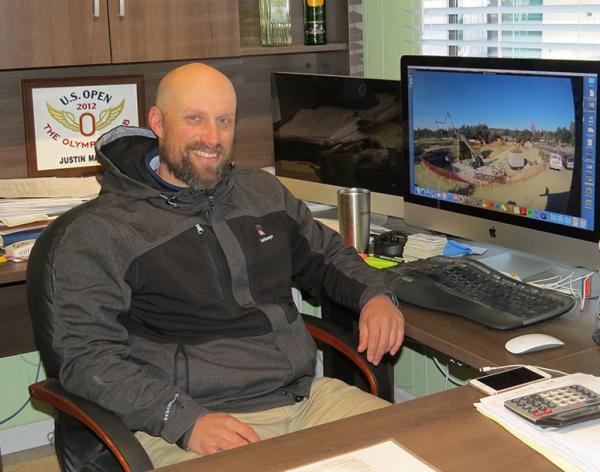There hasn't been much in the way of rainfall throughout much of California the past few years, but there are dark clouds on the horizon, just not the kind golf course superintendents have been hoping for.
 Looming challenges like escalating labor and health care costs, along with the all-too-familiar hurdles associated with years of drought are presenting obstacles that are largely unique to golf course operators in California.
Looming challenges like escalating labor and health care costs, along with the all-too-familiar hurdles associated with years of drought are presenting obstacles that are largely unique to golf course operators in California.Other states have faced prolonged drought, and operators throughout the country will have to deal with increased health care costs thanks to, oddly enough, legislation known as the Affordable Care Act. But few, if any, places across the country are faced with all three of these challenges - at the same time.
"I feel like there is a storm coming in golf in California," said Justin Mandon, superintendent at Pasatiempo Golf Club in Santa Cruz.
"It starts with the water, which has been on everyone's mind the last five years, and it's at the forefront of what we have all been struggling with and we will continue to struggle with. It's not going away."
Although state-imposed restrictions on urban water use implemented in June 2015 were lifted in May, drought conditions, according to the U.S. Drought Monitor, still persist across much of the state prompting officials in Sacramento to leave it up to the California's 408 water districts to develop their own conservation plans.
The outcome is predictable as water purveyors are passing their losses - as usage statewide decreases - onto their customers. Even challenges like the ongoing water crisis can bring opportunities.
"The escalating cost of water has changed the landscape in California for ever, and I think it's for the better," said Kevin Breen, superintendent at La Rinconada Country Club in Los Gatos, a well-to-do Silicon Valley community southwest of San Jose. "Just about every golf course out here has reduced the amount of acreage of irrigated turf to native areas, and I don't see anyone going back. The price per unit of water is just so high."
Labor costs are equally concerning. The statewide minimum wage stands at $10 per hour, will rise to $10.50 per hour on Jan. 1, 2017. It will jump to $11 on Jan. 1, 2018 and again to $15 by 2022. The hourly rate also affects the state's minimum salary for exempt employees, which is twice the minimum wage, so when one goes up, so does the other.
"You can take labor and healthcare, and say all businesses have to deal with that in California, but you add the water, and that is the kicker," Mandon said.
"I don't know how revenue is going to keep up with expenses, so what do you do? For a lot of facilities, it's just going to become too overwhelming."
Factor in the cost of living in California, and some are wondering how they will make ends meet without making drastic changes to their respective operations.
"It's hard to find people, and I don't know if it's going to get any better in finding them or being able to pay them," Breen said.
"One of three things can happen: Golfer expectations will have to go down, they will have to start paying more to play or they'll have to pay for workers and take it on the chin."
 Years of unrealistic expansion have left the golf business vulnerable, and by now, most have accepted that culling the weakest properties from the supply is, barring an unexpected rise in the game's popularity, a necessity. There has been a net loss of nearly 1,000 courses nationwide in the past decade, according to the National Golf Foundation, and self-correction will continue until the market reaches equilibrium between supply and demand.
Years of unrealistic expansion have left the golf business vulnerable, and by now, most have accepted that culling the weakest properties from the supply is, barring an unexpected rise in the game's popularity, a necessity. There has been a net loss of nearly 1,000 courses nationwide in the past decade, according to the National Golf Foundation, and self-correction will continue until the market reaches equilibrium between supply and demand."At least in California, it's going to continue to shake out after many years of growth," said Craig Kessler, director of government affairs for the Southern California Golf Association. "We're just scratching the surface of things that ail the golf industry in California. It is going to be a challenge going forward on all fronts."
Kessler, who has written volumes on the relationship between drought and golf in California, remembers all too clearly the game's glory days in his state, when labor, like land, was cheap, or at least stable, the environmental regulatory culture was less stringent and water ran like manna from heaven.
"The golf industry underwent incredible growth in an era when water and energy were cheap and plentiful, and infrastructure was new," Kessler said.
"Land costed much less, and groundwater was unregulated. You could stick a straw in the ground with impunity and with no regard for your neighbor and pump out what you wanted."
Those days are a memory, and, like Breen in Northern California, Kessler says that's not a bad thing.
In Southern California, where water often is in greater supply than it is in the northern tier of the state, many courses jumped on cash-for-grass programs that paid golf courses for each square foot of managed turf converted to unirrigated native area.
That program along with years of voluntary and mandated cutbacks have changed the look of golf throughout Southern California. And in a state widely known for environmental activism, many players have embraced the change.
"There has been a radical transformation in the look of golf in Southern California, and it's being led by well-heeled private clubs," Kessler said. "They're taking turf out of irrigation and changing overseeding practices. It's a different look and a different feel.
 "There has been a race to 'my club looks more like a Mediterranean climate than yours.' It's a good signal to the rest of the industry."
"There has been a race to 'my club looks more like a Mediterranean climate than yours.' It's a good signal to the rest of the industry."Cash for grass hasn't caught on to that extent in Northern California, but converting managed turf to native plants certainly has. So has the search for cheaper sources of water.
At Pasatiempo, the cost of potable water from Santa Cruz has skyrocketed, including a 40 percent rate hike in October.
Pasatiempo soon will be getting most of its water through a new recycled system that is due to go online in mid 2017. The club paid neighboring Scotts Valley up front for a guaranteed 35 million gallons of recycled water per year for 30 years. It will go into effect once construction is complete on infrastructure, including a massive underground storage tank.
That project, which was overwhelmingly approved by Pasatiempo's membership, had been discussed for about a decade. The drought and the long-term damage it could mean for Pasatiempo finally helped sell city and water officials on its merit.
"When you start talking about jobs with city council and people in the community, I think that's when you start to get some reaction," Mandon said. "This is a historic golf course that has been in Santa Cruz for 85 years and employs over 100 people. There aren't too many businesses here that have been around that long and employ that many people."
With nearly 900 golf courses, California, like most places is overbuilt, said Ted Horton, a retired superintendent and consultant who founded the state's chapter of the golf course owners association. Properties that haven't prepared for the future, like Pasatiempo has, will be hard pressed to meet the mounting challenges, he said.
"Golf did not do itself any favors during the era when it allowed the real estate industry to totally control the development of golf," Horton said.
"Then the golf courses, when the houses are built, are sold for pennies on the dollar, and they put the mom and pop courses that you and I and everyone loves to learn to play on, out of business.
"Golf has has gone through two world wars and survived them. I'm sure it's going to get through this crisis and survive this, also."

